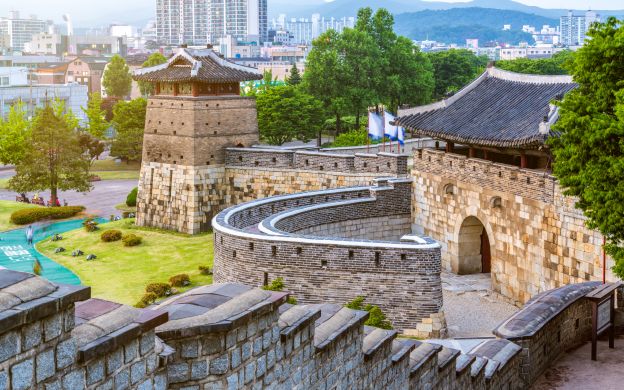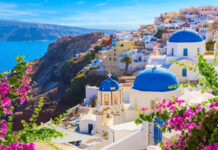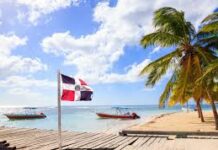Nowadays, South Korea is very famous for its k-pop, k-drama and many international students have been coming to study in Korea. But heritages are also getting famous all over worldwide .Hwaseong fortress is very famous in South Korea for tourists and shows its architectural looks. Hwaseong fortress is recognized for the love of a king to his father. Beautiful Hwaseong fortress is located in Suwon, South Korea and is 30 kilometers away from Seoul. The fortress was constructed in 1796 by South Korean king Jeongjo to honor and in the memory of his father Prince Sado. Prince Sado had committed suicide. The fortress was designated as a world Heritage site by UNESCO in 1997. The wall named Suwonhwaseong of Hwaseong Fortress surrounds the Centre of Suwon .Suwon is the capital city of Gyeonggi-do province situated in South Korea.
The fortress was built by the king Jeongjo, who was the 22nd king of the Joseon Dynasty .The fortress represents the rich 18th century military architecture, ideas from some of the famous and best examples in Europe and East Asia. Hwaseong fortress is unique, because it is built in both flat and hilly land, which makes the use of terrain for maximum defensive efficacy. Hwaseong Fortress stands as a best kudos architect of South Korea’s to come across with the West during the late 18th century. The unbreakable joint of both of Western and Eastern values is represented by Hwaseong Fortress in a beneficial way. The combination of tradition and values of western and eastern styles makes the fortress clearly distinct from various Korean based buildings.
The wall is around 6 km long and it includes four gates. Formerly, 48 structures were assembled atop of the wall of the fortress but now seven of the structures have been lost due to flooding, wars etc. The fortress includes four gates, “Hwaseomun”, “Janganmun”, “Paldalmun,” and Changnyongmun. The largest gates of the fortress are Janganmun and Paldamun and are likeness of Seoul’s Namdaemun (gate) in roof design and its wooden and stone work. The gates were costed a huge during Korean War because the Paldalmun was burned down and reconstructed in 1975. King Jengjo desired to move the capital to Suwon because of the north gate’s grand and royal design .These defensive efforts were concentrated on all hwasenong fortress’s four main gates. The gate of north janganmun and the gate of south paldalmun are the attractive two storey wooden buildings were exaggerated by intricate wood work and multifaceted of hand painting Dancheong designs.
The fortress highlights a floodgate, guard platforms, four secret gates, two observation towers, two archer’s platforms, five sentry towers, a beacon tower and nine bastions, five firearms bastions, two command posts and four angle towers. The parapets are made by stone and brick, akin to most of the fortress, and were 1.2 metres (4 ft.) in height. The beacon tower consists of five chimneys to illustrate various signals with fire or smoke. Signals like one fire denote peace, two fire denotes that the enemy had been noticed, three fire denotes that the enemy approached, four denotes that the enemy had entered in the city.
Dongsam chi is the third eastern turret, built for a short distance from the wall to enable the guards to watch and attack the muggers who had reached inside the fortress. Today the seoammun which is the west secret gate is easily accessible from the road outside, which shows its beautiful looks the detached palace called Haenggung was constructed within the walls of fortress to the house of king jeongjo, when he was away from his palace located in Seoul for worshipping his father’s tomb
Beyond going in its beautiful architectural looks and big size, what makes the fortress amazing is that how and why it was built and its shocking story. A horrific death makes an inspiration to the Korean prince to construct such a fortress unlike which was not made in Asia ever. The fortress was built, because king jeongjo wants to move the capital from Seoul to Suwon. Suwon is tactically positioned to hook up Seoul with the Yellow Sea and China. The king believed that Suwon had the potential to grow and develop into a new and wealthy capital. To promote growth in Suwon, he ordered people to move to Suwon at substantial expense and the people were exempted from taxes for ten years. To show loyalty to his family and strengthen his power, to protect his father’s burial place and protect the southern area of Suwon, the king built the fortress. The city Suwon is ordinarily known as “The City of Filial Piety”. To build the Hwaseong fortress, 700,000 man-hours was required and charged the national treasury 870,000 nyang, nyang was the currency at that time, and 1,500 rice sacks to pay the workers to build it.
The fortress was damaged twice. First, it was damaged when Korea was controlled by japan in the early 20th century and secondly during the Korean War but now most of its original features have been restored and are safe now. Today also the fortress shines and shows the rich culture of South Korea. Many tourists get attracted towards the fortress every year. It is glad that these numbers are increasing. The main feature of the fortress is that it is constructed on both flat and hilly lands, so this type of construction is uncommon in neighboring countries like japan and china. Main stream of Suwon which runs through the middle of construction of the fortress was a response to the downfall of the Korean front line during the war of Imjin. Minister Chae Jae-gong supervised the building process of the fortress .New tools like Geojunggi , a type of a crane ,were made by the engineers to rebuilt the fortress .The original fortress was finished in 1801.
While now, the modern neighbourhoods have been bounced around these old fortress structures, they have been skirted by busy roads, however their splendor has not been distressed. Permitting the city to develop and constantly protecting the heritage of Korea, Suwon city is truly unique for its history and heritage due to the fortress. The hwaseong fortress is incredible and is South Korea’s jewel filled with the love affection of a son to his father.
| By Tanishka Santosh Thorat |











